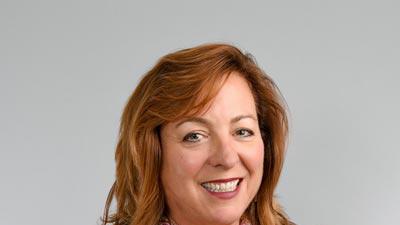CRN Interview: Riverbed Channel Leader Bisnette On Simplifying Partner Program And The $4.6B New Business Opportunity
Riverbed channel chief Bridget Bisnette tells CRN that the company is looking to partners to help break Riverbed out of its traditional WAN optimization arena and into SD-WAN and networking and application performance.

Blasting The Past
Bridget Bisnette considers traditional, competency-based channel partner programs "very 1990s." So, when she and her team set out to restructure Riverbed's program, they decided to make a clean break with the past.
The result is a significantly simplified program that focuses on winning new business and allowing partners to blaze their own trail as they help break Riverbed out of its traditional WAN optimization arena and into next-generation technologies like SD-WAN, networking performance and application performance.
With its focus on new technologies and as-a-service sales strategies, Riverbed's program is aimed at winning new business, and the opportunity there is huge. Bisnette, who came to Riverbed in May, estimates that Riverbed has a $4.6 billion new business opportunity in front of it with some 16,000 customers that haven't bought Riverbed before.
"We need partners to bring Riverbed into their customer base where they haven't brought us in before," Bisnette said. "A lot of times, we're viewed as a WAN optimization company, and that's the wheelhouse they sell us in. We need them to bring us in with SD-WAN. We need them to do that with both new logos and our install base. We're a channel company. Our route to market is partners. We can't be successful unless our partners are aligned with our sales teams."
What follows is an edited excerpt of Bisnette's conversation with CRN.

Are you leaving that traditional model behind completely, or will there still be traditional elements in the program?
I look at this as a 100 percent overhaul of our current channel program. There are not a lot of parallels you could draw between the past and present. With the customers' change in how they want to consume technology, combined with Riverbed's extended portfolio, we had to rewrite the rules of what our relationship will be like as a vendor in respect to a partner. Things are just different. The traditional competency-based program is very 1990s. If I am a CDW, and I'm providing desktop support to 2,000 employees located around the world, why would I as a vendor require them to have six engineers in Chicago where their office is? We're breaking those rules. We've completely disconnected the typical competency-based association with benefits.

What does the structure look like now?
It's performance-based. Our partner are rewarded based on new customer acquisition and selling across the portfolio into existing customers in either a trade-up or consumption model -- we need partners to help us get SD-WAN, network performance and application performance into our install base and we will reward them on X-as-a-service. Any way they are delivering our technology that ultimately ends up in a services-type model, we'll reward them for that. The final area is around competencies and capabilities. We still believe that it's very important to partners to have access to training and capabilities, how to sell, install and develop our type of technology. However, because partners are so diverse, and they're in this transformational stage, we don't believe it's the vendor's responsibility to dictate to them how many, where, when. We want to offer it to them and we want them to make a decision based on their business what the right competencies are that they need.

What is it about your partner base that led you to that conclusion?
This is a second-generation channel. They have no reason to not have customer success. They understand that if they're not successful with the customer, they won't be in business. Dictating that kind of requirement to them just seems very old-school. As a company, we've adopted a different approach, and we want the partners to develop their capabilities based on the model they have.

Will it be easier for partners to sell subscription-based technologies under a system like this?
I believe it will be easier for them. One of the tenets of our program is simplicity. Flexibility is the other, and profitability is the third. From a simplicity standpoint, we're looking for velocity. We're looking for improving relationships between Riverbed and the partner in the hopes of creating velocity in the relationship, and therefore some volume. In order to be successful in the commercial market, we have to create a frictionless system that extends to our partner. We look at this launch as a partner experience change. We're not just launching a program, we're launching a portal. It's the partner experience we're really trying to simplify so they can sell more, faster.

How ready is Riverbed's partner base for this, and what have partners been telling you as you were developing the new program?
They're very ready. I came to Riverbed in May and the first thing I did was sit down and talk to partners about their relationship with Riverbed and how we could improve that experience to mutually grow our businesses. A lot of these changes we've put in place came from there. We used that as our design guidance. We took them with us on this journey. We had meetings with key partners, and I wish I could have taped them. There were definitely a lot of wows.

Can you share an example or two?
We modeled four quarters running if we had this program before. We did some simulations with them. Our old program took about 37 slides to present. This program takes five. That alone made them go, 'Wow.' Most partners who align to this new program are directly aligned to our sales strategy. We are lining up our sellers and our channel to the same objectives and the same performance, and they can earn anywhere between 2X and 4X what they have traditionally earned from Riverbed. We created the capability for them to bank their rewards, and they can spend it in any way. They can spend it in a rebate, in business development funds or in training funds. We're telling the partner, 'You decide. You have a business model, you decide how to spend these.' We have some guide rails, I need them to be reinvesting in the business. They can adjust based on the needs of their business. They can fund sales headcount, they can do spiffs with it. We have traditionally had very restrictive business development rules. We opened that up. They will earn rewards when they take training and get certified. They can take that money and reinvest in more training.

Does it also lighten the load for Riverbed, eliminating the need to keep and maintain a standing MDF program, for example?
There are two ways it's going to help us, and it also helps the partner. Partners have to deal with hundreds of vendor programs, and reconcile them, program-manage them. We wanted to make sure our program was not going to create a huge burden on them and was simple enough. I estimate that approximately 15 percent of productivity in the channel is wasted on administrative in channel programs, specifically tracking partners to competencies and whether partners have got training or not, rather than performance. This is going to give us the ability to take those resources and focus them on productivity. A lot of companies come out with a lot of promotions, but instead of going to the partners with these promotions, I'm going to say give me X, Y, Z dividends and I'm going to roll out to partners the ability to make 2X dividends on these portfolios. I don't have a new administrative overhead to manage and administer and create collateral.

You want partners selling across the portfolio, but are there specific areas where you need more partner focus and concentration?
We are in customer acquisition mode, and we're building out the commercial sales operation. SD-WAN, network performance, user experience and application performance are incremental areas we need more penetration on. We believe those are customer acquisition offers. We still have WAN optimization but we can attract new logos with that broader portfolio, and we can do that through our existing partners. If there are partners in the marketplace that aren't Riverbed partners today, and they believe they can grow our pipeline with net new customers for us, we will certainly bring on new partners. We are in customer acquisition mode, not partner acquisition mode, but we will on-board new partners when it makes sense.

Are you seeing new types of customers because you're dealing in new types of technology, SD-WAN, for example?
Absolutely. When we did the business case in May, we assessed the portfolio and the customer market that was available to Riverbed. In America alone, we identified $4.6 billion worth of TAM [total addressable market] that was now available to Riverbed that was not available to Riverbed a year, or 18 months, before. The changes in consumption make it easier to sell as a service rather than a hardware transaction. It's opened up the market for us. That's why Riverbed added the commercial sales organization. We're focused on our sales, and we're incentivizing our partners to hunt with us and cross-sell the portfolio.

What do you need from partners that you are not getting today?
We need partners to bring Riverbed into their customer base where they haven't brought us in before. A lot of times, we're viewed as a WAN optimization company, and that's the wheelhouse they sell us in. We need them to bring us in with SD-WAN. We need them to do that with both new logos and our install base. We're a channel company. Our route to market is partners. We can't be successful unless our partners are aligned with our sales teams.

How are you approaching partner recruitment?
We are not doing partner recruitment. We're doing customer acquisition. We've introduced some forensic data analytics to Riverbed and brought in some business intelligence, and we've identified those customers right down to their locations across the United States, about 16,000 customers available to us that we haven't previously sold to. I need capacity from partners, but we're doing it from the end user in. If we need to add partners, we'll add partners to bring in that business, but we are not in partner recruitment mode.
You think you can do this with your existing partner base?
We think we can do it with our partner base and some 'X'. The way our partners sell technology is changing from Capex deals to having revenue over time. That's taking down their top line. Even if their bottom line stays healthy, they've got to augment that and get volumes up as well. I think our partners have capacity today, but we'll bring on another partner if it gets us a customer we don't have today.

Are your internal sales folks getting marching orders about helping partners with account acquisition?
They actually are executing it now. We took all those named accounts, and we're building out an inside sales organization in Austin, [Texas], this year. They've built out plans that say, 'Let's go after these accounts.' Those individuals are calling on customers to create demand with the partners. It's all partner-led, but it's a two-pronged attack on those 16,000 customers. This program brings the incentive proposition to the partner on why they should hunt with Riverbed.

When it comes to software-defined, or as-a-service offerings, why should a partner place its bets with Riverbed rather than a competitor?
We have best-in-class technology. We are not lacking in the quality of our technology, and in many cases, we have superior technology to our competition. We believe that this program is the second value proposition to this. We have a very strong portfolio, and this program incentivizes and rewards you regardless of how you sell. We are aligning our sales teams to the partner. When you have cooperation with sales teams in the field, as opposed to the competitive situations where vendor salespeople feel they're selling against partners, that's going to differentiate us.
Will this allow partners to close more deals?
Absolutely. And we want them to close more deals faster.